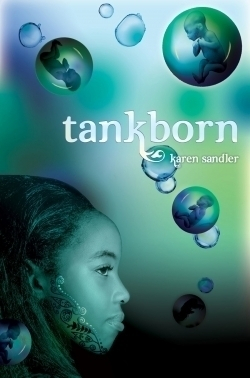Tankborn
Reaching beyond an exciting, dystopian plot, Karen Sandler tells the alarming story of a society that has come to devalue humans, turning many of them into commodities, and the courage it takes to face the truth needed to fight oppression.
Kayla 6982, of the Chadi sector on the planet Loka, is anxiously awaiting her fifteenth birthday, when she will be given her first Assignment. As a GEN, a Genetically Engineered Non-human, she was pieced together by gene splicers and gestated in a tank, designed to have particular traits and attributes that will make her most valuable in serving “real” humans. With a facial tattoo that distinguishes her as a GEN and allows for “uploads” of information, Kayla knows that she will be expected to serve in whatever role she is handed for the rest of her life. When she learns that her Assignment is to care for the aging patriarch of a trueborn family, she quickly becomes involved in a countermovement, one that must stop a terrible conspiracy and work to find justice and freedom for all humans.
Sandler took the time to craft a full society and culture in Loka, creating an eerily plausible world. The well-developed, skin color-based caste system is particularly notable and brought to life vividly when the characters confront its consequences and constraints, including the overall violent mistreatment of GENS. Characters at each level feel the social and economic positioning, disparities, and inequalities, from the lowest level GENs like Kayla to the most privileged Devak.
Sandler’s development of two distinct religions, one practiced by GENS and one practiced by the trueborns, also gives readers a clear understanding of the belief systems of the people of Loka. Her attention to details like vernacular speech, jewelry, clothing, and social behaviors lend Loka a distinct level of realism.
Most impressive, however, is how the world she creates so naturally begs further questioning and exploration. A caste system in general, and especially one so cruelly and strictly implemented as this one, brings up questions of racism and classism. Similarly, the idea of how genetic engineering could so easily be abused, is wholly integrated into the book and directly confronts the notion of what defines humanity. Corporate greed and ethical business practices are also addressed.
Although it’s tailored to science-fiction buffs, such thought-provoking themes and the high level of character development, as well as an engaging plot, make the book ideal for a wide audience. Especially well suited for the publisher’s recommended seventh- to twelfth-grade readers,, the story pushes the genre into a new realm by featuring a dark-skinned heroine—yet another feature assuring that readers will take away a more critical eye with which to view the world around them.
Reviewed by
Alicia Sondhi
Disclosure: This article is not an endorsement, but a review. The publisher of this book provided free copies of the book to have their book reviewed by a professional reviewer. No fee was paid by the publisher for this review. Foreword Reviews only recommends books that we love. Foreword Magazine, Inc. is disclosing this in accordance with the Federal Trade Commission’s 16 CFR, Part 255.

